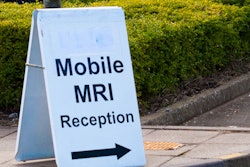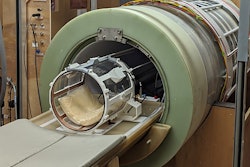Using portable MRI in an ambulance during transport of patients experiencing stroke shows promise for improving outcomes, but there's more work to be done to streamline the process, according to survey results published June 25 in Ergonomics.
"MRI uses magnetic fields, radio frequency pulses, and computers to detect abnormal changes in the brain," wrote a team led by Arvind Kolangarakath, PhD, of Clemson University in South Carolina. "Though MRI scans take longer than CT scans, they are more accurate and sensitive … portable MRI scanners are now emerging as a flexible option. These devices have lower magnetic fields and allow healthcare personnel to transport the machine almost anywhere within the facility, facilitating scans of patients with substantial ease."
Stroke is the second main cause of mortality around the world, the group noted. "Door-to-needle" time -- that is, time elapsed from a patient's hospital arrival to the administration of stroke treatment -- is a key factor to a positive outcome. CT and MRI are the main imaging modalities used to evaluate stroke, and although MRI exams take longer, they are more accurate and sensitive, Kolangarakath and colleagues noted.
Previous research has shown the feasibility of using point-of-care portable MRI from a telemedicine-equipped ambulance while a patient is being transported. In this follow-up study, Kolangarakath's group sought to identify barriers to implementing such a protocol using the Systems Engineering Initiative for Patient Safety (SEIPS2.0) framework, which covers three areas: the work system, the processes that pertain to the work system, and outcomes.
This study included 18 participants, 11 of whom were paramedics and seven of whom were neurologists (three of these were neuroradiologists). The vehicle proposed was a Ford F550 XLT ambulance and the investigators noted dimensions of the patient compartment and patient loading and handling procedures. The authors conducted 45- to 60-minute Zoom interviews with study participants between September and November 2023; the interview included a project overview, a simulation video, and a process flow chart describing the stroke care protocol. From the interviews, the investigators developed a set of codes according to the SEIPS framework that corresponded to potential barriers to the use of portable MRI in an ambulance with stroke patients.
Barriers included (but were not limited to) the following, and the researchers reported participant comments:
- Inadequate training of paramedics in MRI operation for stroke diagnosis. "Maybe some ideas on how to troubleshoot, just in case we run into issues in the field," one survey participant wrote. You know, just some brief explanation on uncommon problems that you know that could be expected with a device."
- Increased physical demands on paramedics. "Is there enough room for us to safely scoot the patient forward without injuring our backs? Because that's where a lot of injuries happen for us, lifting and moving patients," another said.
- Patient discomfort and/or anxiety. "We have patients that are … claustrophobic [when] the doors to the ambulance are being closed," one respondent noted.
- Airway management challenges. "I'm not truly sure how big the scanner is within the ambulance. But would it impede the paramedic or the crew members' ability to actively perform patient care should something happen while in the scanner?" a participant asked.
- Patient positioning challenges in a moving vehicle. "[Is there] a way to raise a stretcher within the ambulance?" one respondent queried.
- Communication between ambulance and emergency room teams. "If I called the hospital for my ambulance and asked the charge nurse to [connect me to] the neurologist, [there would probably be] a little bit of delay before they could track one down and put them on the radio," a study participant noted.
The research team also noted that the scan duration of 10 to 15 minutes could obstruct the effectiveness of using portable MRI for stroke diagnosis in urban settings, writing that "once the patient is loaded into the ambulance, the total scan time, including patient setup, may exceed 20 minutes, taking up a substantial portion of the transport phase" and that "scanning during transit may not significantly expedite their diagnosis and treatment compared to being transported directly to a nearby stroke care center."
Nevertheless, portable MRI conducted from an ambulance does show promise for improving the care of patients experiencing stroke, according to the group.
"By understanding and addressing [challenges posed by portable MRI] through human-centered methods, it may be possible to develop better solutions for integrating MRI systems into ambulances that meet all the requirements and targets," the authors concluded. "This advancement could significantly enhance the rapid diagnosis and treatment of stroke patients, offering substantial benefits to prehospital emergency care."
The complete study can be found here.



.fFmgij6Hin.png?auto=compress%2Cformat&fit=crop&h=100&q=70&w=100)




.fFmgij6Hin.png?auto=compress%2Cformat&fit=crop&h=167&q=70&w=250)











